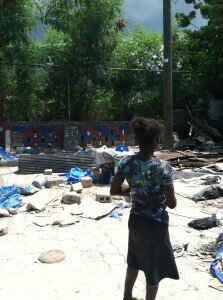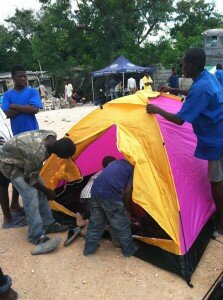Final whistle for 514 families as Haitian government illegally closes stadium camp
By Beatrice Lindstrom, Human rights lawyer and Lawyers’ Earthquake Response Network (LERN) Fellow at the Institute for Justice and Democracy in Haiti/ Bureau des Avocats Internationaux,
This post was co-authored by Jocelyn Brooks, who is an Ella Baker associate at the Center for Constitutional Rights, based at the Bureau des Avocats Internationaux (BAI) in Port-au-Prince, Haiti.
We watch an aged man pull his cart out of Sylvio Cator Stadium’s back gate, maneuvering it precariously between a parked car and a steep gutter. His cart is heavy and stacked high with wood, tarp, and the bare essentials of his life. He pulls the cart behind him, muscles and bones protruding from the strain.
This man is one of the last evictees to leave Sylvio Cator Stadium in downtown Port-au-Prince, the site that has been home to thousands of people displaced by last year’s earthquake. The government is set on using the stadium for a soccer game in early August, and on July 18, the mayor of Port-au-Prince unlawfully evicted the last of the residents living in the Stadium’s parking lot, forcing many onto the streets, into other camps, or into hazardous structures in danger of collapsing from earthquake damage.
While the Mayor’s office touts the closure of the camp as a success, the eviction at Sylvio Cator stadium was carried out in violation of Haitian and international law. Mayor Jean-Yves Jason appeared at the stadium with armed police less than a week earlier to inform residents that they would have to leave their homes imminently. He held a few closed meetings with select members of the camp committee, but did not permit other residents to participate in the planning and relocation, as mandated by the UN Guiding Principles on Internal Displacement. The eviction was also carried out without a judicial order, which is required under Haitian law. Moreover, in November 2010, the Inter-American Commission on Human Rights instructed state actors to take measures to protect the rights to the displaced against forced evictions, but none of these were heeded.
Instead, the Mayor used a combination of physical and economic coercion to remove the residents from the land. He promised each family $250 to leave the site, and then returned to forcibly evict those who did not accept the compensation. In addition, it appears that around 70 families may have lost their temporary homes without any compensation. While the camp committee counted 514 families remaining in the camp at the time of the eviction, the mayor’s list — used to coordinate compensation — had only 442 families on it.
Payment strategies like this one do not lead to durable solutions, especially when the government does not ensure that the payment enables access to adequate alternative housing. In Place Saint Pierre in the wealthy suburb of Petionville, the municipal government implemented a similar strategy in April, paying displaced families $500 — twice as much as offered in this case — to vacate a public square. Limited investigations showed that families who accepted the compensation remained displaced and homeless after receiving the money because it was inadequate to secure alternative housing. Government officials even admitted that the money offered was generally insufficient to cover rent for a family of five in Port-au-Prince.
While private landowners and government agents have been carrying out evictions since shortly after the earthquake, the eviction of Sylvio Cator is of particular significance. The camp is one of six that President Martelly committed to closing in the first 100 days of his administration. Under the Martelly plan, displaced residents are paid a fixed amount to move out of camps into existing structures, most of which are currently uninhabitable due to earthquake damage. While the compensation is meant to pay for repair and reconstruction, the amounts are not based on an evaluation of actual costs, and it is unclear what supervision will ensure that the construction is earthquake-proof. Furthermore, the plan gives property owners money to repair rental units on the condition that they make them available rent-free for 2 or 5 years, depending on the level of repair needed. Without adequate legal protections, however, this is difficult if not impossible to enforce and has the potential of benefiting property owners at the expense of renters displaced by the earthquake.
As human rights lawyers working to protect the internally displaced from further displacement and vulnerability, we visited the Sylvio Cator stadium to monitor and document the unlawful eviction. In one corner of the parking lot, a woman sat in the shade next to her disassembled tent. She told us she accepted the money offered by the mayor and would leave that evening because she had no other choice. Anyone who remained beyond the deadline risked violence at the hands of the government, as occurred in April 2010, when the police came to forcibly push out over 7,000 people from the soccer field. Other individuals we met said that they also would comply, but most feared that the money would not allow them to obtain housing.
Under international law, the Government must ensure that evicted residents have access to adequate alternative housing before they are evicted. But for those who are forced to leave their camps without support to find proper housing, even more dangerous housing — if not outright homelessness — often awaits. A recent study commissioned by USAID found that 64% of the buildings requiring demolition and 92% of the buildings requiring repair as a result of earthquake damage have been reoccupied, even in their precarious state.
For some residents of Sylvio Cator, the Government provided a relocation site off Rue Bicentenaire. The site sits on a small plot of land a 20-minute walk from the stadium, in one of the more dangerous sections of the city. The land fits about 100 families–far less than the 514 evicted families, most of whom are in desperate need of housing. When we arrived, a group of children were struggling to raise a tent. Flimsy tents were the only form of shelter provided on the new site. They measured around 4 feet tall and were not large enough to sleep more than three people.
Flooding on the site has also rendered the land unsuitable for other purposes, and standing water creates an ongoing public health risk for the new occupants. It’s rainy season in Haiti, and cholera is surging again. Yet there was no access to free, potable water. To use latrines, residents must cross the street to access ones that have been set up in the median of a busy highway. Eighteen months after the earthquake, it is difficult to see how anyone could consider this adequate housing.
As we surveyed the relocation site, we witnessed the approach of the man with his heavy cart. He had had to navigate his way through street sludge and over-crowded sidewalks to arrive at the small field. Like him, most residents we encountered had to struggle to move their belongings to the new site without any logistical support from the government or aid organizations. Residents were similarly abandoned as to future assistance: the government failed to collect residents’ contact information ahead of the expulsion to enable follow-up.
Although the Martelly administration has asserted that the mayor acted on his own outside of the framework of the 100-day plan, the president’s failure to stop or condemn the eviction of Sylvio Cator stadium belies an alarming reluctance to protect the rights of Haiti’s displaced. Furthermore, the money for the relocation was reported to have come from both the mayor and President Martelly.
In the context of an ongoing housing crisis and massive internal displacement, the government’s prioritization of soccer over the wellbeing of over 500 vulnerable families — many of whom now face homelessness and severe insecurity — is outrageous. The director of Sylvio Cator Stadium justified the eviction, stating that “the presence of victims in the courtyard of the stadium was a violation of the right of footballers and lovers of the sport.” This is a profound misrepresentation of human rights law and the special care the government is obligated to afford internally displaced persons. Rather than infringing, or allowing others to infringe, the rights of displaced persons, the government must exercise leadership to protect the victims of last year’s earthquake.
This past week President Martelly presented his 100-day plan to the international community, who will fund the $93 million price tag. While resettlement is an urgently needed step towards recovery, the international community must demand that the relocations are carried out in a manner that respects and prioritizes the rights of the displaced. Furthermore, the President must ensure that no camp is closed until all residents have been resettled into adequate alternative housing, lest he violate his obligations to Haiti’s most vulnerable.
—
This article is a part of a media and advocacy campaign to stop evictions from displacement camps in Haiti. Haitian and international human rights organizations are asking the Government of Haiti, the U.S. Congress, the Interim Haiti Recovery Commission, and other actors with an influence in Haiti, to stand up against evictions. To support our efforts, visit http://lethaitilive.org/no-evictions/ and www.haitijustice.org. Follow #noevictions on Twitter.




COMMENTS